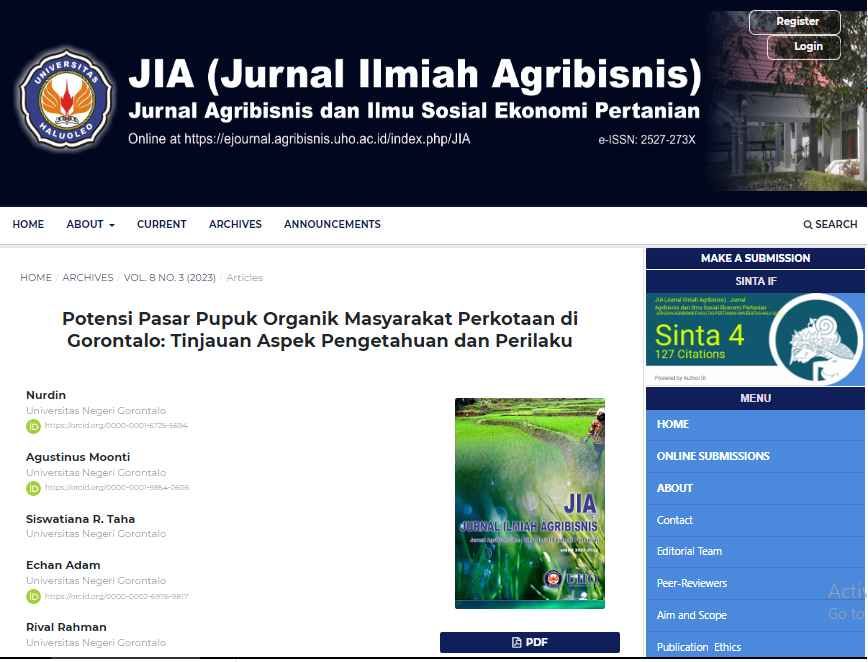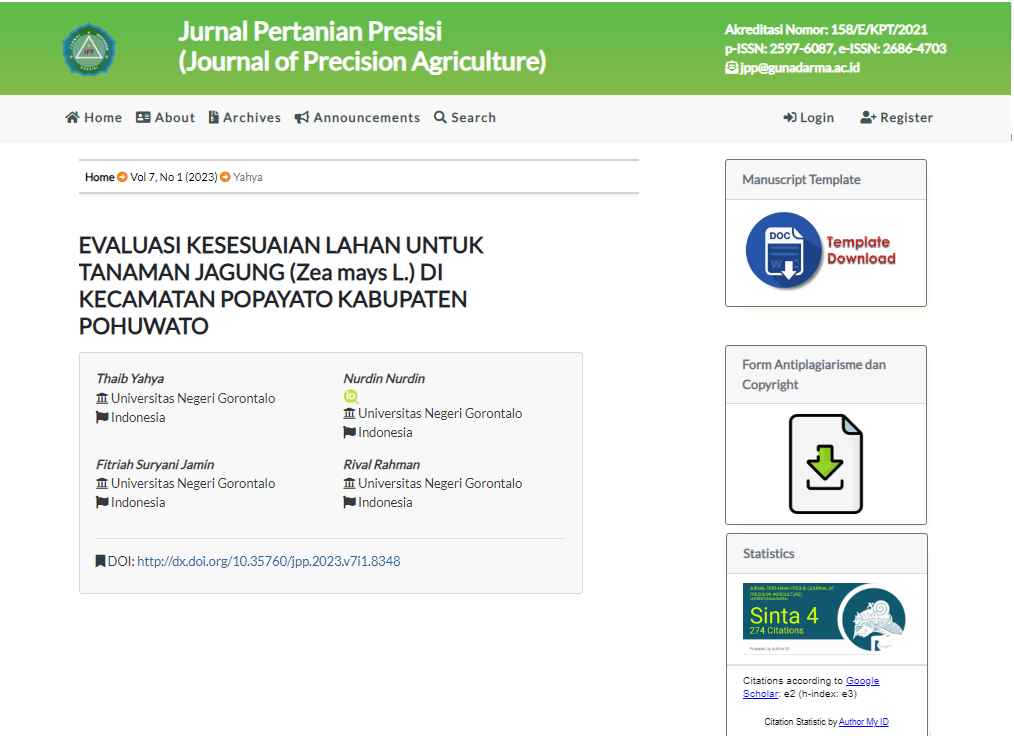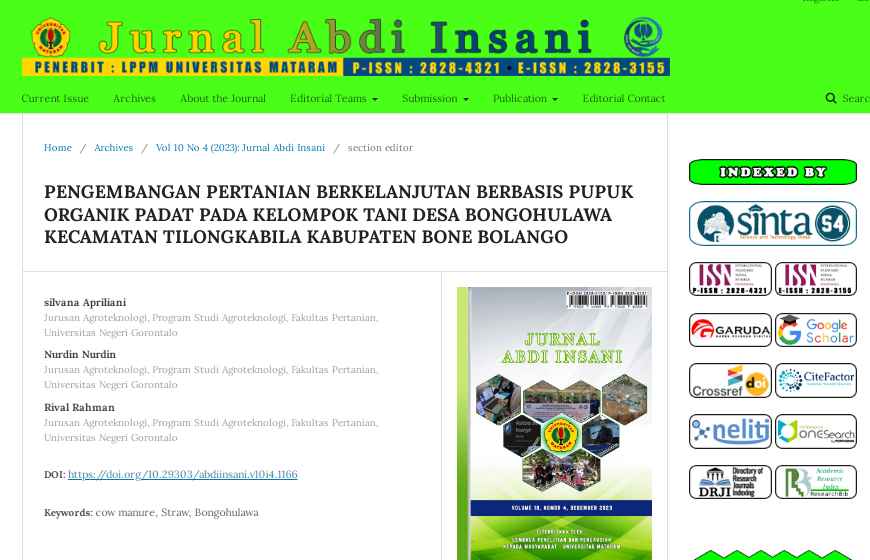Potensi Pasar Pupuk Organik Masyarakat Perkotaan di Gorontalo: Tinjauan Aspek Pengetahuan dan Perilaku

JIA (Jurnal Ilmiah Agribisnis) : Jurnal Agribisnis Dan Ilmu Sosial Ekonomi Pertanian, 8(3), 2023: 199–206.
Nurdin, Agustinus Moonti, Siswatiana R. Taha, Echan Adam, Rival Rahman
Universitas Negeri Gorontalo
ABSTRACT
This research aims to describe changes in the use of organic fertilizers in urban communities, both from the point of view of knowledge and behavior. This research was conducted in the period from February to April 2022. The population is urban in Gorontalo Province, with a random sample of 172 people with various professional characteristics. The research variables include people's perceptions, knowledge, and behavior regarding using organic fertilizers. Data were analyzed using descriptive statistics. The results showed that 95.3% of the urban community's perception of a suitable type of fertilizer chose organic fertilizer over non-organic fertilizer, and from the aspect of knowledge, as much as 69.8% knew the benefits of using organic fertilizer, both for plants and the environment and economic benefits. From the behavioral aspect, 83.7% of people are used to using organic fertilizers, and 62.8% prefer to use organic fertilizers compared to other fertilizers. The market potential for organic fertilizer for urban communities in Gorontalo Province based on aspects of knowledge and behavior is relatively high so that marketing can target urban communities. Communities can use agricultural shops with good reputations or images to obtain or trade organic fertilizers.
Keywords: Attitude, Citizen, Civil, Market, Organic Fertilizer.
Analisis Kebutuhan Air Tanaman Selada (Lactuca sativa L.) pada Inceptisol dan Vertisol Berbasis Internet of Things (IoT)

Jurnal Tanah Dan Sumberdaya Lahan, 10(2), 2023: 417–424.
Yayan Poga, Nurdin, Wawan Pembengo
Program Studi Agroteknologi Fakultas Pertanian Universitas Negeri Gorontalo
Abstrac
tLactuca sativa L. has good economic prospects, but lettuce production often declines due to the unmet water requirement of lettuce. This study aimed to determine the water needs of lettuce on Inceptisol and Vertisol based on the Internet of Things (IoT). The location study was in the green house, Huluduotamo Village, Bone Bolango Regency, from September to October 2021, while the Vertisol and Inceptisol samples were from Sidomukti Village, Gorontalo Regency. This study used the Penman method with the Cropwat 8.0 application which was integrated with a smartphone through the Blynk (IoT) application. The water requirement yield of lettuce plants in September on Vertisol and Inceptisol in the early phase was 2.45 mm/day, the middle phase was 3.73 mm/day, and the final phase was 3.54 mm/day. Soil moisture detection device at field capacity moisture content produces 319 Analog Digital Converter (ADC) and soil in moist conditions reaches 534 ADC. The analog data value of the water content of the Inceptisol field capacity is 343 ADC and the soil in a moist state is 574 ADC. The performance of the device for detecting soil moisture in the water condition of the 15% field capacity of Vertisol and 22% Inceptisol is more effective than the gravimetric method.
Keywords: Cropwat 8.0, Internet of Things (IoT), Lactuca sativa L.
Evaluasi Kesesuaian Lahan untuk Padi Sawah (Oriza sativa L.) di Kecamatan Pinogu Kabupaten Bone Bolango, Indonesia

Agroteknika, Vol 6 No 2 (2023), Desember 2023: 138-148.
Roy Harun, Nurdin, Nurmi, Rival Rahman
Universitas Negeri Gorontalo
Abstract
Penambahan luas lahan sawah penting dilakukan untuk meningatkan produksi padi sawah, tetapi informasi potensi lahan tersebut sering belum tersedia. Tujuan dilaksanakannya penelitian ini yaitu menentukan kelas kesesuaian lahan dan faktor pembatas penggunaan lahan untuk padi sawah, serta menilai kelayakan usahatani padi sawah. Pelaksanakan penelitian dari Juni hingga Agustus 2021 di wilayah Kecamatan Pinogu, Kabupaten Bone Bolango. Penelitian menggunakan metode pemadanan antara kriteria kesesuaian tanaman padi sawah dengan karakteristik lahan setiap satuan lahan, sehingga didapatkan kelas kesesuaian aktual dan faktor pembatas lahannya. Setelah faktor pembatas diperbaiki, maka didapatkan kelas kesesuaian potensial yang diteruskan dengan analisis kelayakan usaha padi sawah berdasarkan aspek finansial. Hasil analisis menunjukan bahwa secara aktual, kelas kesesuaian lahan didominasi sesuai marginal (kelas S3) diikuti cukup sesuai (kelas S2) untuk padi sawah di Kecamatan Pinogu Kabupaten Bone Bolango dengan pembatas adalah faktor kejenuhan basa. Selanjutnya, setelah perbaikan kelas dengan pemberian bahan organik dan kapur, maka secara potensial kelas kesesuaian lahan untuk padi sawah didominasi kelas S2 diikuti kelas S1 (sangat sesuai). Usahatani padi sawah di wilayah ini relatif menguntungkan karena R/C rasio lebih besar 1.
Evaluasi kesesuaian lahan untuk tanaman jagung (Zea mays L.) di Kecamatan Popayato Kabupaten Pohuwato

Jurnal Pertanian Presisi (Journal of Precision Agriculture), Vol 7, No 1 (2023)
Thaib Yahya, Nurdin, Fitriah Suryani Jamin, Rival RahmanUniversitas Negeri Gorontalo, Indonesia
Abstract
Utilization of land resources requires information of the potential and limitations of land use so that the commodity that will be cultivated can achieve optimal yields. The aim of this study was to determine land suitability class of maize (Zea mays L.) of agriculture land in Popayato District, Pohuwato Regensy. This research was conducted from July 2022 to December 2022. Land suitability classes, both actual and potential, were determined based on the matching method between land characteristics of each land unit with the land suitability criteria for maize. The results showed that the actual land suitability class for maize in Popayato District was dominated by marginally suitable (S3 class) respectively at about 95.32% and not suitable (N class) about 4.68% of total area. Limiting factors consisting of class S3 includes: rainfall and humidity, soil depth, base saturation and pH, while the limiting factors in class N was soil depth. After improvement efforts were made, the potential land suitability class for maize plants became S3 class for all land units with an area of 3,587.37 ha.KeywordsSuitability; land; actual; potential; maize; Popayato
Pengembangan Pertanian Berkelanjutan Berbasis Pupuk Organik Padat Pada Kelompok Tani Desa Bongohulawa Kecamatan Tilongkabila Kabupaten Bone Bolango

Jurnal Abdi Insani, 10(4), 2487-2496
Silvana Apriliani, Nurdin, Rival Rahman
Jurusan Agroteknologi, Program Studi Agroteknologi, Fakultas Pertanian, Universitas Negeri Gorontalo
Abstract
Currently, many people know that the use of inorganic materials in plant cultivation can have negative effects on human health and the environment. So it is very necessary to increase plant productivity by implementing organic plant cultivation technology that is sustainable and environmentally friendly. Bongohulawa Village, Tilongkabila District, Bone Bolango Regency is a village where some of the population is engaged in farming and animal husbandry, but the farming community does not utilize livestock manure and plant litter waste which is used as a basic ingredient for making solid organic fertilizer. The aim of the community service activity is to provide training in making solid organic fertilizer from cow manure and rice straw litter in Bongohulawa village, Bone Bolango subdistrict. The methods used in this activity are the material provision stage and the training stage. The training stage involves carrying out demonstrations in making solid organic fertilizer for farmer groups using cow manure, rice straw litter, EM4 bioactivator as basic ingredients. During community service activities, most farmer groups have problems with a lack of knowledge about fertilizers made from organic raw materials such as cow dung waste and rice straw waste which can improve the physical, chemical and biological properties of the soil so that the farmer group community has high enthusiasm because of the material and training regarding Making organic fertilizer and rice straw is something new for farmer groups. It is hoped that the technology provided to farmer groups can be implemented when cultivating plants, in order to produce food and a healthy and sustainable environment. In conclusion, this solid organic fertilizer activity can be applied to improve soil fertility, increase production and can open up business opportunities for organic fertilizer in attractive packaging with high selling value.
Keywords: cow manure, Straw, Bongohulawa
Kategori
- Abstract 2006
- Abstract 2009
- Abstract 2011
- Abstract 2012
- Abstract 2013
- Abstract 2014
- Abstract 2016
- Abstract 2018
- Abstract 2019
- Abstract 2020
- Abstract 2021
- Abstract 2022
- Abstract 2023
- Abstract 2024
- Abstract 2025
- Buku
- Kiprah Tugas Pembantuan ASN-Dosen
- Kunjungan Luar Negeri
- Mata Kuliah
- Pengukuhan Guru Besar, Prof. Dr. Nurdin, SP, MSi
- Project 2009
- Project 2010
- Project 2013
- Project 2018
- Project 2019
- Project 2020
- Project 2021
- Project 2022
- Publikasi Ilmiahku
- Soil Scientist from Gorontalo
Arsip
Blogroll
- a-SintaID
- b-Google Scholar
- c-Scopus ID
- d-Web of Science (WoS) ID
- e-ResearchGate
- f-Academia.edu
- g-SciProfiles
- h-Loop ID
- i-LinkedIn
- j-OrcidID
- k-figshare
- l-Youtube
- m-Twitter
- n-Facebook
- o-Universitas Negeri Gorontalo
- p-BIMA-Kemendikbud RI
- q-FAPERTA UNG
- r-LP2M UNG
- s- LP3M UNG
- t-SIMPPM UNG
- u-SIMLIT UNG
- v-Rispro LPDP
- w-BRIIN
- x-PDDIKTI
- y-GRS BPDPKS
- z-kampusmerdeka
- z1-ANJANI
- z10-SIAT UNG
- z11-Aplikasi SIAGA
- z12-SPADA Indonesia
- z13-SISTER
- z14-tesaurus.kemdikbud
- z15-UKBI
- z16-typoonline
- z17-Turnitin
- z18-Zetero
- z2-eHAKI
- z20-Himpunan Ilmu Tanah Indonesia(HITI)
- z21-BKN
- z21-Kementan RI
- z22-BPS Provinsi Gorontalo
- z23-BPS Kabupaten Boalemo
- z24-BPS Kabupaten Bone Bolango
- z25-BPS Kabupaten Gorontalo
- z26-BPS Kabupaten Gorontalo Utara
- z27-BPS Kabupaten Pohuwato
- z3-Arjuna
- z4-DIKTI
- z5-GARUDA Dikti
- z6-SIM Karier dan SDM Kemendikbud
- z7-KBBI
- z8-Kedaireka
- z9-RAMA
